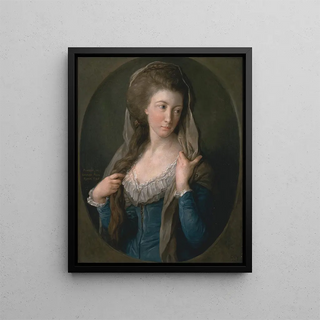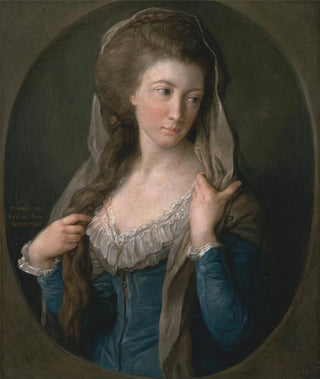Art print | Portrait of a woman traditionally identified as Margaret Stuart Lady Hippisley - Pompeo Batoni


View from behind

Frame (optional)
Art print of the Portrait of a Woman traditionally identified as Margaret Stuart Lady Hippisley - Pompeo Batoni – Captivating introduction
The "Portrait of a Woman traditionally identified as Margaret Stuart Lady Hippisley" by Pompeo Batoni is an iconic work that transcends the simple frame of the portrait to immerse us in a universe where beauty and sophistication meet. Created in the 18th century, this painting embodies not only the refined aesthetics of its time but also a deep understanding of human psychology. The depiction of this woman, whose gaze appears both direct and mysterious, invites the viewer to question her identity and personal history. The soft light caressing her face and the meticulous details of her attire evoke a world of grace and delicacy, testifying to the undeniable talent of the artist.
Style and uniqueness of the work
Batoni's work stands out for its unique style, blending classicism with a more modern sensibility. The treatment of drapery, for example, reveals a remarkable mastery of textures, each fold telling a story of movement and life. The color palette, subtle and harmonious, helps create an intimate atmosphere that envelops the subject. The woman depicted seems to emerge from the canvas, as if ready to engage in conversation with the viewer. This blend of realism and delicacy in the portrayal of features and emotions gives this work a rare depth. Every detail, from the sparkling jewelry to the elaborate hairstyle, is carefully thought out, highlighting the social status of the figure while giving her a human and accessible dimension.
The artist and his influence
Pompeo Batoni, a major figure of 18th-century Italian painting, knew how to mark his era with his innovative approach to the portrait. Trained in the classical tradition, he managed to incorporate elements of rococo, bringing lightness and liveliness to his compositions. Batoni was a sought-after portraitist by European aristocracy, and his influence extends beyond his works, touching many artists who followed in his footsteps. His talent lay in his ability to capture not only the physical appearance of his subjects but also their essence, their character. In this way, he paved the way for a new way of conceiving the portrait, where

Matte finish

View from behind

Frame (optional)
Art print of the Portrait of a Woman traditionally identified as Margaret Stuart Lady Hippisley - Pompeo Batoni – Captivating introduction
The "Portrait of a Woman traditionally identified as Margaret Stuart Lady Hippisley" by Pompeo Batoni is an iconic work that transcends the simple frame of the portrait to immerse us in a universe where beauty and sophistication meet. Created in the 18th century, this painting embodies not only the refined aesthetics of its time but also a deep understanding of human psychology. The depiction of this woman, whose gaze appears both direct and mysterious, invites the viewer to question her identity and personal history. The soft light caressing her face and the meticulous details of her attire evoke a world of grace and delicacy, testifying to the undeniable talent of the artist.
Style and uniqueness of the work
Batoni's work stands out for its unique style, blending classicism with a more modern sensibility. The treatment of drapery, for example, reveals a remarkable mastery of textures, each fold telling a story of movement and life. The color palette, subtle and harmonious, helps create an intimate atmosphere that envelops the subject. The woman depicted seems to emerge from the canvas, as if ready to engage in conversation with the viewer. This blend of realism and delicacy in the portrayal of features and emotions gives this work a rare depth. Every detail, from the sparkling jewelry to the elaborate hairstyle, is carefully thought out, highlighting the social status of the figure while giving her a human and accessible dimension.
The artist and his influence
Pompeo Batoni, a major figure of 18th-century Italian painting, knew how to mark his era with his innovative approach to the portrait. Trained in the classical tradition, he managed to incorporate elements of rococo, bringing lightness and liveliness to his compositions. Batoni was a sought-after portraitist by European aristocracy, and his influence extends beyond his works, touching many artists who followed in his footsteps. His talent lay in his ability to capture not only the physical appearance of his subjects but also their essence, their character. In this way, he paved the way for a new way of conceiving the portrait, where






